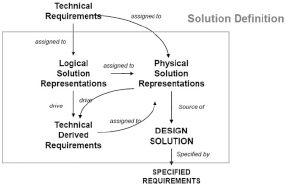7
Designing Solutions and Design Models
7.1. Introduction
As mentioned in the introductory Chapter 5, the composition of a technological system is made up of building blocks that its endo-structure assembles (see Figure 5.2, Chapter 5). The same design process is applied for each building block, except for terminal blocks that (1) do not require design, (2) are designed somewhere or (3) have already been designed.
The design process of each block is composed of two subprocesses:
In Chapter 6, we described the process of definition of the requirements assigned to the type of systems targeted. In this chapter, we will discuss on the second subprocess, that is to say defining one or more solutions.
We know that design problems are “inverse” problems, meaning that they can have multiple solutions, which is why we use the expression “definition of one or more solutions” rather than “definition of the solution”.
Figure 7.1. EIA632 building block solution definition subprocess

The definition of a design solution involves multiple activities: (1) design of a logical solution, (2) allocation and derivation of part of the technical requirements of the system to the logical solution under consideration, (3) design of a physical solution, (4) allocation of the logical ...
Get Model Based Systems Engineering: Fundamentals and Methods now with the O’Reilly learning platform.
O’Reilly members experience books, live events, courses curated by job role, and more from O’Reilly and nearly 200 top publishers.

